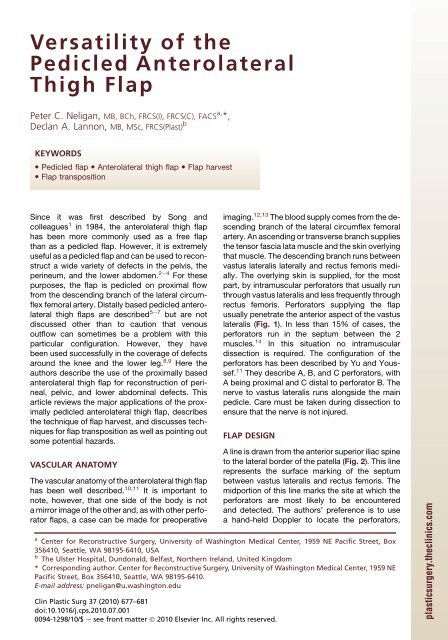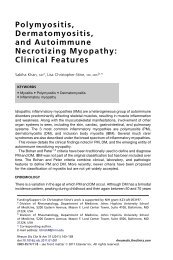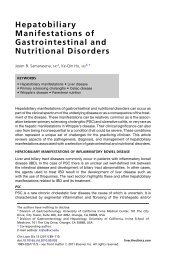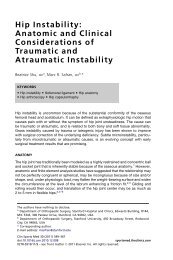Versatility of the Pedicled Anterolateral Thigh Flap - The Clinics
Versatility of the Pedicled Anterolateral Thigh Flap - The Clinics
Versatility of the Pedicled Anterolateral Thigh Flap - The Clinics
You also want an ePaper? Increase the reach of your titles
YUMPU automatically turns print PDFs into web optimized ePapers that Google loves.
<strong>Versatility</strong> <strong>of</strong> <strong>the</strong><br />
<strong>Pedicled</strong> <strong>Anterolateral</strong><br />
<strong>Thigh</strong> <strong>Flap</strong><br />
Peter C. Neligan, MB, BCh, FRCS(I), FRCS(C), FACS a, *,<br />
Declan A. Lannon, MB, MSc, FRCS(Plast) b<br />
KEYWORDS<br />
<strong>Pedicled</strong> flap <strong>Anterolateral</strong> thigh flap <strong>Flap</strong> harvest<br />
<strong>Flap</strong> transposition<br />
Since it was first described by Song and<br />
colleagues 1 in 1984, <strong>the</strong> anterolateral thigh flap<br />
has been more commonly used as a free flap<br />
than as a pedicled flap. However, it is extremely<br />
useful as a pedicled flap and can be used to reconstruct<br />
a wide variety <strong>of</strong> defects in <strong>the</strong> pelvis, <strong>the</strong><br />
perineum, and <strong>the</strong> lower abdomen. 2e4 For <strong>the</strong>se<br />
purposes, <strong>the</strong> flap is pedicled on proximal flow<br />
from <strong>the</strong> descending branch <strong>of</strong> <strong>the</strong> lateral circumflex<br />
femoral artery. Distally based pedicled anterolateral<br />
thigh flaps are described 5e7 but are not<br />
discussed o<strong>the</strong>r than to caution that venous<br />
outflow can sometimes be a problem with this<br />
particular configuration. However, <strong>the</strong>y have<br />
been used successfully in <strong>the</strong> coverage <strong>of</strong> defects<br />
around <strong>the</strong> knee and <strong>the</strong> lower leg. 8,9 Here <strong>the</strong><br />
authors describe <strong>the</strong> use <strong>of</strong> <strong>the</strong> proximally based<br />
anterolateral thigh flap for reconstruction <strong>of</strong> perineal,<br />
pelvic, and lower abdominal defects. This<br />
article reviews <strong>the</strong> major applications <strong>of</strong> <strong>the</strong> proximally<br />
pedicled anterolateral thigh flap, describes<br />
<strong>the</strong> technique <strong>of</strong> flap harvest, and discusses techniques<br />
for flap transposition as well as pointing out<br />
some potential hazards.<br />
VASCULAR ANATOMY<br />
<strong>The</strong> vascular anatomy <strong>of</strong> <strong>the</strong> anterolateral thigh flap<br />
has been well described. 10,11 It is important to<br />
note, however, that one side <strong>of</strong> <strong>the</strong> body is not<br />
a mirror image <strong>of</strong> <strong>the</strong> o<strong>the</strong>r and, as with o<strong>the</strong>r perforator<br />
flaps, a case can be made for preoperative<br />
imaging. 12,13 <strong>The</strong> blood supply comes from <strong>the</strong> descending<br />
branch <strong>of</strong> <strong>the</strong> lateral circumflex femoral<br />
artery. An ascending or transverse branch supplies<br />
<strong>the</strong> tensor fascia lata muscle and <strong>the</strong> skin overlying<br />
that muscle. <strong>The</strong> descending branch runs between<br />
vastus lateralis laterally and rectus femoris medially.<br />
<strong>The</strong> overlying skin is supplied, for <strong>the</strong> most<br />
part, by intramuscular perforators that usually run<br />
through vastus lateralis and less frequently through<br />
rectus femoris. Perforators supplying <strong>the</strong> flap<br />
usually penetrate <strong>the</strong> anterior aspect <strong>of</strong> <strong>the</strong> vastus<br />
lateralis (Fig. 1). In less than 15% <strong>of</strong> cases, <strong>the</strong><br />
perforators run in <strong>the</strong> septum between <strong>the</strong> 2<br />
muscles. 14 In this situation no intramuscular<br />
dissection is required. <strong>The</strong> configuration <strong>of</strong> <strong>the</strong><br />
perforators has been described by Yu and Youssef.<br />
11 <strong>The</strong>y describe A, B, and C perforators, with<br />
A being proximal and C distal to perforator B. <strong>The</strong><br />
nerve to vastus lateralis runs alongside <strong>the</strong> main<br />
pedicle. Care must be taken during dissection to<br />
ensure that <strong>the</strong> nerve is not injured.<br />
FLAP DESIGN<br />
A line is drawn from <strong>the</strong> anterior superior iliac spine<br />
to <strong>the</strong> lateral border <strong>of</strong> <strong>the</strong> patella (Fig. 2). This line<br />
represents <strong>the</strong> surface marking <strong>of</strong> <strong>the</strong> septum<br />
between vastus lateralis and rectus femoris. <strong>The</strong><br />
midportion <strong>of</strong> this line marks <strong>the</strong> site at which <strong>the</strong><br />
perforators are most likely to be encountered<br />
and detected. <strong>The</strong> authors’ preference is to use<br />
a hand-held Doppler to locate <strong>the</strong> perforators,<br />
a<br />
Center for Reconstructive Surgery, University <strong>of</strong> Washington Medical Center, 1959 NE Pacific Street, Box<br />
356410, Seattle, WA 98195-6410, USA<br />
b<br />
<strong>The</strong> Ulster Hospital, Dundonald, Belfast, Nor<strong>the</strong>rn Ireland, United Kingdom<br />
* Corresponding author. Center for Reconstructive Surgery, University <strong>of</strong> Washington Medical Center, 1959 NE<br />
Pacific Street, Box 356410, Seattle, WA 98195-6410.<br />
E-mail address: pneligan@u.washington.edu<br />
Clin Plastic Surg 37 (2010) 677–681<br />
doi:10.1016/j.cps.2010.07.001<br />
0094-1298/10/$ e see front matter Ó 2010 Elsevier Inc. All rights reserved. plasticsurgery.<strong>the</strong>clinics.com
678<br />
Neligan & Lannon<br />
Fig. 1. <strong>The</strong> lateral circumflex artery (A), a branch <strong>of</strong><br />
<strong>the</strong> pr<strong>of</strong>unda femoris, has a lateral (ascending) branch<br />
(B) that supplies <strong>the</strong> tensor fasciae lata muscle (TFL)<br />
and a descending branch (C) that supplies <strong>the</strong> anterolateral<br />
thigh flap. This vessels runs under rectus femoris<br />
(RF) and <strong>the</strong>n in <strong>the</strong> septum, between rectus<br />
femoris and vastus lateralis (VL).<br />
recognizing that this method may not always be<br />
accurate. 15 <strong>The</strong> flap can be raised to include any<br />
<strong>of</strong> <strong>the</strong> elements supplied by <strong>the</strong> vasculature. It<br />
can incorporate muscle (vastus lateralis), fascia,<br />
and skin. <strong>The</strong> choice <strong>of</strong> which tissues to include<br />
will be dictated by <strong>the</strong> reconstructive requirements.<br />
<strong>The</strong> technique may be modified accordingly.<br />
For many <strong>of</strong> <strong>the</strong> reconstructive applications<br />
that a pedicled anterolateral thigh flap can address<br />
in <strong>the</strong> lower abdomen, <strong>the</strong> fascial element <strong>of</strong> <strong>the</strong><br />
Fig. 2. A line drawn between <strong>the</strong> anterior superior<br />
iliac spine and <strong>the</strong> lateral border <strong>of</strong> <strong>the</strong> patella is<br />
<strong>the</strong> surface marking <strong>of</strong> <strong>the</strong> septum between rectus<br />
femoris and vastus lateralis. <strong>The</strong> midportion <strong>of</strong> this<br />
line is where perforators will be found.<br />
flap can be important, which is particularly <strong>the</strong><br />
case when reconstructing through abdominal<br />
wall defects. Often, <strong>the</strong> amount <strong>of</strong> fascia required<br />
is larger than <strong>the</strong> amount <strong>of</strong> skin required. If this<br />
is <strong>the</strong> case, an excess <strong>of</strong> fascia over skin can easily<br />
be harvested (Fig. 3). Vascularized fascia lata in<br />
abdominal wall reconstruction is said to have <strong>the</strong><br />
advantage <strong>of</strong> preventing adhes between <strong>the</strong> fascia<br />
and <strong>the</strong> abdominal viscera. 16 If no fascia is<br />
required for <strong>the</strong> reconstruction, <strong>the</strong>n a skin-only<br />
flap can be designed and <strong>the</strong> fascia simply incised<br />
around <strong>the</strong> perforators (Fig. 4). Fur<strong>the</strong>rmore, if<br />
muscle is a required element <strong>of</strong> <strong>the</strong> reconstruction,<br />
<strong>the</strong> flap can be raised as a myocutaneous flap<br />
incorporating <strong>the</strong> vastus lateralis muscle. <strong>The</strong><br />
technique <strong>of</strong> dissection will depend on what<br />
elements are being included with <strong>the</strong> flap. <strong>The</strong><br />
dimensions <strong>of</strong> <strong>the</strong> flap will obviously be dictated<br />
by <strong>the</strong> size <strong>of</strong> <strong>the</strong> defect to be reconstructed.<br />
However, <strong>the</strong> vascular pedicle <strong>of</strong> <strong>the</strong> anterolateral<br />
thigh can carry a large flap (up to 30 cm). To<br />
perfuse such a large skin paddle, however, more<br />
than 1 perforator may need to be harvested with<br />
<strong>the</strong> flap. If multiple perforators are available, it is<br />
judicious to sequentially clamp <strong>the</strong>m so as to<br />
ensure that <strong>the</strong> selected perforators will perfuse<br />
<strong>the</strong> flap (see Fig. 4). Pedicle length can also be<br />
particularly important when <strong>the</strong> flap is being designed<br />
as a pedicled flap; <strong>the</strong> longer <strong>the</strong> pedicle,<br />
<strong>the</strong> greater <strong>the</strong> arc <strong>of</strong> rotation. Preoperative<br />
imaging may be particularly helpful when planning<br />
a pedicled anterolateral thigh flap because <strong>the</strong><br />
location <strong>of</strong> <strong>the</strong> perforator has a bearing on pedicle<br />
length and, <strong>the</strong>refore, on <strong>the</strong> arc <strong>of</strong> rotation <strong>of</strong> <strong>the</strong><br />
flap. A distally placed perforator, <strong>the</strong> C perforator<br />
according to Yu’s classification, can add considerable<br />
length and can be chosen if it is <strong>of</strong> appropriate<br />
size. <strong>The</strong> more distal perforators, however, tend to<br />
Fig. 3. <strong>The</strong> amount <strong>of</strong> fascia harvested with this flap<br />
exceeds <strong>the</strong> amount <strong>of</strong> skin. This picture shows <strong>the</strong><br />
excess thigh fascia being sutured to <strong>the</strong> abdominal<br />
wall fascia.
Fig. 4. In this suprafascial flap dissection, 2 perforators<br />
have been isolated. A microvascular clamp has<br />
been placed on <strong>the</strong> proximal perforator to ensure<br />
that <strong>the</strong> distal perforator can perfuse <strong>the</strong> whole flap.<br />
have a longer intramuscular course. Although <strong>the</strong><br />
extra pedicle length gained from dissecting <strong>the</strong>se<br />
perforators may be desirable, <strong>the</strong> amount <strong>of</strong> intramuscular<br />
dissection can be an important issue.<br />
Regardless <strong>of</strong> <strong>the</strong> position <strong>of</strong> <strong>the</strong> perforator, size<br />
is important and <strong>the</strong> perforator needs clinical evaluation<br />
to ensure that it can adequately perfuse <strong>the</strong><br />
flap. As already mentioned, if ever <strong>the</strong>re is any<br />
doubt, sequentially clamping <strong>the</strong> perforators (see<br />
Fig. 4) can be a good way to determine which<br />
perforator <strong>of</strong>fers <strong>the</strong> best perfusion.<br />
<strong>The</strong> width <strong>of</strong> <strong>the</strong> flap is also important because it<br />
will determine whe<strong>the</strong>r or not <strong>the</strong> donor site will<br />
need a skin graft or whe<strong>the</strong>r it can be closed by<br />
direct approximation. Direct closure is desirable<br />
because a skin graft in this area is unsightly and<br />
not always well tolerated by patients. Although it<br />
is generally accepted that a width <strong>of</strong> 8 cm can<br />
usually be closed directly, it has been <strong>the</strong> authors’<br />
experience that much wider defects can be closed<br />
directly. If <strong>the</strong> flap does not contain fascia, it is<br />
generally much easier to close <strong>the</strong> donor defect<br />
than when <strong>the</strong> fascia has been harvested with<br />
<strong>the</strong> flap because <strong>the</strong> fascia contains and<br />
constrains <strong>the</strong> thigh musculature, which, when<br />
fascia has been harvested with <strong>the</strong> flap, tends to<br />
bulge and make closure more difficult. Regardless<br />
<strong>of</strong> whe<strong>the</strong>r or not fascia has been harvested with<br />
<strong>the</strong> flap, penetrating towel clamps can be used<br />
to temporarily approximate <strong>the</strong> wound edges<br />
(Fig. 5) allowing sufficient tissue creep to facilitate<br />
closure. Care must be exercised, however, in situations<br />
where patients are unable to report symptoms<br />
that might indicate too tight a closure. <strong>The</strong><br />
authors have encountered 2 cases <strong>of</strong> compartment<br />
syndrome, in <strong>the</strong> presence <strong>of</strong> epidural anes<strong>the</strong>sia,<br />
that was caused by a closure that was too<br />
tight. 17<br />
<strong>Pedicled</strong> <strong>Anterolateral</strong> <strong>Thigh</strong> <strong>Flap</strong> 679<br />
Fig. 5. Penetrating towel clamps are used to temporarily<br />
approximate <strong>the</strong> wound edges to facilitate<br />
closure. If closure is this tight, it is important to ensure<br />
that patients are in a fit condition to report symptoms<br />
<strong>of</strong> compartment syndrome.<br />
ARC OF ROTATION<br />
<strong>The</strong> proximally pedicled anterolateral thigh flap will<br />
easily reach <strong>the</strong> lower abdomen and perineum.<br />
2,18e20 As already mentioned, choosing<br />
a more distal perforator increases <strong>the</strong> length <strong>of</strong><br />
<strong>the</strong> pedicle and, <strong>the</strong>refore, <strong>the</strong> arc <strong>of</strong> rotation.<br />
However, size is important when choosing an<br />
appropriate perforator. Choosing a distal perforator<br />
simply because <strong>of</strong> position and not because<br />
<strong>of</strong> size is not advised. <strong>The</strong> arc <strong>of</strong> rotation is also<br />
determined by <strong>the</strong> method by which <strong>the</strong> flap is<br />
transferred. <strong>The</strong> lateral circumflex femoral artery<br />
is a branch <strong>of</strong> <strong>the</strong> pr<strong>of</strong>unda femoris. <strong>The</strong> artery<br />
comes <strong>of</strong>f <strong>the</strong> lateral aspect <strong>of</strong> <strong>the</strong> pr<strong>of</strong>unda at<br />
a point that is medial to <strong>the</strong> proximal segment <strong>of</strong><br />
<strong>the</strong> rectus femoris muscle. It runs under that<br />
muscle and eventually runs between <strong>the</strong> rectus<br />
femoris and vastus lateralis muscles. To dissect<br />
<strong>the</strong> pedicle to its origin, <strong>the</strong> rectus femoris must<br />
be retracted. Tunneling <strong>the</strong> flap under <strong>the</strong> rectus<br />
femoris (Fig. 6) increases its arc <strong>of</strong> rotation and<br />
allows <strong>the</strong> flap to reach <strong>the</strong> perineum and lower<br />
abdomen. For more lateral defects <strong>of</strong> <strong>the</strong> lower<br />
abdomen or thigh, tunneling under rectus femoris<br />
<strong>of</strong>fers no advantage. In fact it may shorten <strong>the</strong><br />
arc <strong>of</strong> rotation in that direction. Sometimes<br />
dividing <strong>the</strong> main pedicle to rectus femoris, as<br />
<strong>the</strong> flap is tunneled under this muscle, will significantly<br />
increase <strong>the</strong> arc <strong>of</strong> rotation. However,<br />
caution is required in relation to <strong>the</strong>se maneuvers<br />
because ischemic damage to <strong>the</strong> rectus femoris<br />
muscle may result from division <strong>of</strong> its main<br />
pedicle, 21 and denervation may result from<br />
tunneling under its proximal third because it is<br />
innervated by 2 to 4 nerve branches entering posteromedially<br />
in this region. 22<br />
In addition, <strong>the</strong> saphenous vein is at risk during<br />
medial subcutaneous tunnelling. 23 If rectus femoris<br />
pedicle ligation is being considered intraoperatively,<br />
it is prudent to clamp <strong>the</strong> pedicle and<br />
observe for muscle vascularity before pedicle division.<br />
<strong>The</strong> donor site is closed primarily in layers or
680<br />
Neligan & Lannon<br />
Fig. 6. (A) Defect following radical excision <strong>of</strong> metastatic<br />
carcinoma to <strong>the</strong> groin. (B) A tunnel is created<br />
under rectus femoris through which <strong>the</strong> flap can be<br />
passed. (C) <strong>Flap</strong> inset into lower abdominal defect.<br />
by using a split-thickness skin graft depending on<br />
<strong>the</strong> width <strong>of</strong> <strong>the</strong> flap harvested and patient characteristics.<br />
Primary closure <strong>of</strong> <strong>the</strong> fascia is required if<br />
suprafascial flap harvesting has been performed to<br />
prevent muscle hernia, which can be painful. In <strong>the</strong><br />
authors’ experience, <strong>the</strong> arc <strong>of</strong> rotation extends to<br />
<strong>the</strong> lower costal margin, <strong>the</strong> posterior superior iliac<br />
spine, <strong>the</strong> trochanteric area, <strong>the</strong> anterior margin <strong>of</strong><br />
anus, and <strong>the</strong> contralateral iliac fossa. Previous<br />
reports have indicated that <strong>the</strong> flap will reach to<br />
8 cm above <strong>the</strong> umbilicus, <strong>the</strong> contralateral lower<br />
abdomen and inguinal area, <strong>the</strong> entire groin, and<br />
perineum to anus. 24 Gravvanis and colleagues 2<br />
have also described its use in coverage <strong>of</strong> a variety<br />
<strong>of</strong> defects.<br />
AVOIDING COMPLICATIONS<br />
Attention to detail can help avoid complications in<br />
using this flap. Careful selection <strong>of</strong> <strong>the</strong> appropriate<br />
perforators is <strong>the</strong> first step. Care must also be<br />
taken to avoid any injury to <strong>the</strong> pedicle during<br />
dissection. As already mentioned, it is important<br />
to try to preserve <strong>the</strong> nerve to vastus lateralis.<br />
Judicious division <strong>of</strong> <strong>the</strong> pedicle to rectus femoris<br />
is important. It is important to avoid tension in <strong>the</strong><br />
pedicle and not to ask <strong>the</strong> flap to do too much. If in<br />
any doubt, it is easy to convert to a free anterolateral<br />
thigh flap. If <strong>the</strong> flap is being tunneled from <strong>the</strong><br />
thigh to <strong>the</strong> area to be reconstructed, it is <strong>of</strong> prime<br />
importance to ensure that <strong>the</strong> tunnel is wide<br />
enough not only to accommodate <strong>the</strong> flap but<br />
also to ensure that <strong>the</strong> pedicle will not be under<br />
any pressure in <strong>the</strong> immediate postoperative<br />
period. This point is particularly important in<br />
patients who are obese. <strong>The</strong> authors’ lost 1 flap<br />
in an obese patient as <strong>the</strong> pedicle was avulsed<br />
from <strong>the</strong> flap during passage through a tight<br />
tunnel. It is possible to thin <strong>the</strong> flap, 25 and this<br />
may be considered in patients who are obese.<br />
However, in <strong>the</strong> authors’ practice, morbid obesity<br />
is a relative contraindication for a pedicled anterolateral<br />
thigh flap.<br />
SUMMARY<br />
<strong>The</strong> pedicled anterolateral thigh flap is a useful<br />
addition to our armamentarium. It provides excellent<br />
cover for defects in <strong>the</strong> lower abdomen, pelvis,<br />
and perineum. It also has <strong>the</strong> added advantage <strong>of</strong><br />
not sacrificing any muscle, <strong>the</strong>reby minimizing <strong>the</strong><br />
risk for donor morbidity.<br />
REFERENCES<br />
1. Song YG, Chen GZ, Song YL. <strong>The</strong> free thigh flap:<br />
a new free flap concept based on <strong>the</strong> septocutaneous<br />
artery. Br J Plast Surg 1984;37(2):149e59.<br />
2. Gravvanis AI, Tsoutsos DA, Karakitsos D, et al.<br />
Application <strong>of</strong> <strong>the</strong> pedicled anterolateral thigh flap<br />
to defects from <strong>the</strong> pelvis to <strong>the</strong> knee. Microsurgery<br />
2006;26(6):432e8.<br />
3. Hallock GG. <strong>The</strong> proximal pedicled anterolateral<br />
thigh flap for lower limb coverage. Ann Plast Surg<br />
2005;55(5):466e9.<br />
4. Wang X, Qiao Q, Burd A, et al. Perineum reconstruction<br />
with pedicled anterolateral thigh fasciocutaneous<br />
flap. Ann Plast Surg 2006;56(2):151e5.<br />
5. Pan SC, Yu JC, Shieh SJ, et al. Distally based anterolateral<br />
thigh flap: an anatomic and clinical study.<br />
Plast Reconstr Surg 2004;114(7):1768e75.
6. Heo C, Eun S, Bae R, et al. Distally based<br />
anterolateral-thigh (ALT) flap with <strong>the</strong> aid <strong>of</strong> multidetector<br />
computed tomography. J Plast Reconstr Aes<strong>the</strong>t<br />
Surg 2010;63(5):e465e8.<br />
7. Uygur F, Duman H, Ulkür E, et al. Are reverse flow<br />
fasciocutaneous flaps an appropriate option for <strong>the</strong><br />
reconstruction <strong>of</strong> severe postburn lower extremity<br />
contractures? Ann Plast Surg 2008;61(3):319e24.<br />
8. Lin CH, Hsu CC, Lin CH, et al. Antegrade venous<br />
drainage in a reverse-flow anterolateral thigh flap.<br />
Plast Reconstr Surg 2009;124(5):273ee4e.<br />
9. Cotrufo S, Hart A. A note <strong>of</strong> caution on <strong>the</strong> use <strong>of</strong> <strong>the</strong><br />
distally based anterolateral thigh flap: anatomical<br />
evidence. Plast Reconstr Surg 2010;125(1):30ee1e.<br />
10. Kawai K, Imanishi N, Nakajima H, et al. Vascular<br />
anatomy <strong>of</strong> <strong>the</strong> anterolateral thigh flap. Plast<br />
Reconstr Surg 2004;114(5):1108e17.<br />
11. Yu P, Youssef A. Efficacy <strong>of</strong> <strong>the</strong> handheld Doppler in<br />
preoperative identification <strong>of</strong> <strong>the</strong> cutaneous perforators<br />
in <strong>the</strong> anterolateral thigh flap. Plast Reconstr<br />
Surg 2006;118(4):928e33 [discussion: 934e5].<br />
12. Rozen WM, Ashton MW, Pan WR, et al. Anatomical<br />
variations in <strong>the</strong> harvest <strong>of</strong> anterolateral thigh flap<br />
perforators: a cadaveric and clinical study. Microsurgery<br />
2009;29(1):16e23.<br />
13. Rozen WM, Wagstaff MJ, Grinsell D, et al. <strong>The</strong><br />
course <strong>of</strong> anterolateral thigh perforators does not<br />
correlate between sides <strong>of</strong> <strong>the</strong> body: <strong>the</strong> role for<br />
preoperative imaging. Plast Reconstr Surg 2010;<br />
125(3):132ee4e.<br />
14. Wei FC, Jain V, Celik N, et al. Have we found an ideal<br />
s<strong>of</strong>t-tissue flap? An experience with 672 anterolateral<br />
thigh flaps. Plast Reconstr Surg 2002;109(7):<br />
2219e26 [discussion: 2227e30].<br />
15. Lin SJ, Rabie A, Yu P. Designing <strong>the</strong> anterolateral<br />
thigh flap without preoperative Doppler or imaging.<br />
J Reconstr Microsurg 2009;26(1):67e72.<br />
16. Yildirim S, Taylan G, Akoz T. Use <strong>of</strong> fascia component<br />
<strong>of</strong> <strong>the</strong> anterolateral thigh flap for different<br />
<strong>Pedicled</strong> <strong>Anterolateral</strong> <strong>Thigh</strong> <strong>Flap</strong> 681<br />
reconstructive purposes. Ann Plast Surg 2005;<br />
55(5):479e84.<br />
17. Addison PD, Lannon D, Neligan PC. Compartment<br />
syndrome after closure <strong>of</strong> <strong>the</strong> anterolateral thigh<br />
flap donor site: a report <strong>of</strong> two cases. Ann Plast<br />
Surg 2008;60(6):635e8.<br />
18. Descamps MJ, Hayes PM, Hudson DA. Phalloplasty<br />
in complete aphallia: pedicled anterolateral thigh<br />
flap. J Plast Reconstr Aes<strong>the</strong>t Surg 2009;62(3):<br />
e51e4.<br />
19. H<strong>of</strong>er SO. A pedicled anterolateral thigh flap for<br />
abdominal reconstruction after previous degloving<br />
injury <strong>of</strong> <strong>the</strong> donor site: revascularisation <strong>of</strong> <strong>the</strong><br />
donor site. Scand J Plast Reconstr Surg Hand<br />
Surg 2007;41(4):203e6.<br />
20. Huang LY, Lin H, Liu YT, et al. <strong>Anterolateral</strong> thigh<br />
vastus lateralis myocutaneous flap for vulvar<br />
reconstruction after radical vulvectomy: a preliminary<br />
experience. Gynecol Oncol 2000;78(3 Pt 1):<br />
391e3.<br />
21. Kimata Y, Uchiyama K, Ebihara S, et al. Anatomic variations<br />
and technical problems <strong>of</strong> <strong>the</strong> anterolateral<br />
thigh flap: a report <strong>of</strong> 74 cases. Plast Reconstr Surg<br />
1998;102(5):1517e23.<br />
22. Spyriounis PK. <strong>The</strong> extended approach to <strong>the</strong><br />
vascular pedicle <strong>of</strong> <strong>the</strong> anterolateral thigh perforator<br />
flap: anatomical and clinical study. Plast Reconstr<br />
Surg 2006;117(3):997e1001 [discussion:<br />
1002e3].<br />
23. Yu P, Sanger JR, Matloub HS, et al. <strong>Anterolateral</strong><br />
thigh fasciocutaneous island flaps in perineoscrotal<br />
reconstruction. Plast Reconstr Surg 2002;109(2):<br />
610e6 [discussion: 617e8].<br />
24. Kimata Y, Uchiyama K, Ebihara S, et al. <strong>Anterolateral</strong><br />
thigh flap donor-site complications and morbidity.<br />
Plast Reconstr Surg 2000;106(3):584e9.<br />
25. Kimura N, Satoh K. Consideration <strong>of</strong> a thin flap as an<br />
entity and clinical applications <strong>of</strong> <strong>the</strong> thin anterolateral<br />
thigh flap. Plast Reconstr Surg 1996;97(5):985e92.





